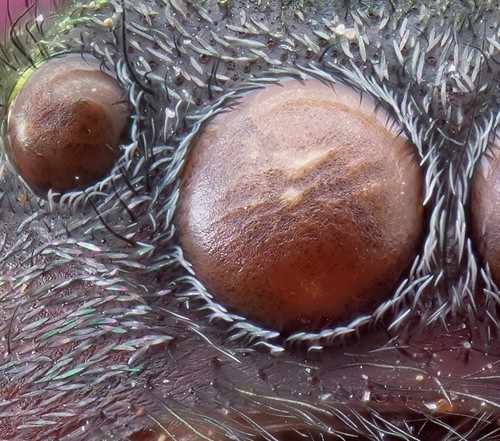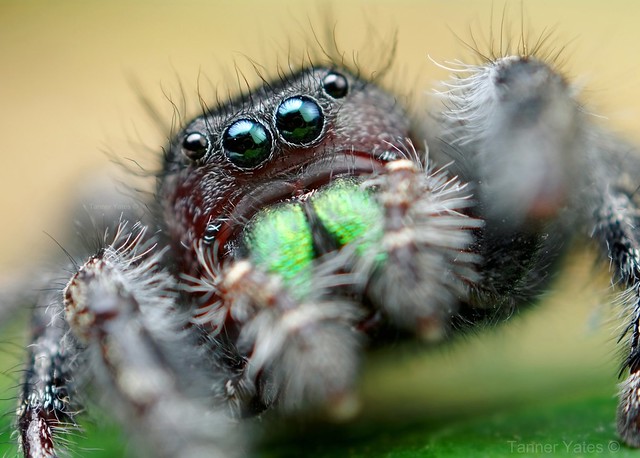LOL, Fred, at your later image. Glad I don't have an avatar. . . .
Regarding the original question, my preference is for the first of the two images. The reflections of the diffuser in the second image give me the impression eye structures that the spider doesn't have, and in general, photographs that give a false impression bother me. So I'd vote for the "cleaned up" version. Not that I'd be happy with the prominent reflection of your flash, but you probably aren't either, and that wasn't the subject of this experiment.
Yesterday, there was a salticid on my window, and I was sorely tempted to experiment with lighting its eyes. Couldn't bring myself to do it--sac'ing a salticid for a quick lighting experiment was beyond me, though I'd certainly do it for a careful photographic study. Of course, I was eating a chicken sandwich, and probably bashed dozens of small flying insects with my car while driving to pick it up, so none of this has any basis in logic.
A question to those who shoot salticids: How long do the eyes continue to look lifelike after the subject is killed?
For a hemi-demi-semi-slightly similar lighting situation, a while back I posted a cluster of
oriental bittersweet. Shooting the waxy, reflective berries reminded me of the shiny-ball exercise sometimes given to beginning photography students. Everywhere I put the lights gave a reflection, so I had to make the reflection work for me. I did cross polarize, but with the reflection completely removed, the waxy surface of the berries was no longer apparent, and I wanted to show this fruiting cluster as it really is. So I dialed some of the reflection back in.
But having this dimmed-down reflection appear nearly everywhere on the berries made it much too prominent, and hid too much of the red-orange color that is a signature of this plant. So I masked off (or "flagged") much of the diffused light with black paper. I kept adding pieces of black paper until I had a balance of reflection and non-reflection that showed the berries to be crinkly and colorful.
Meanwhile, I was also masking off light to tackle another issue. The yellow-tan husks around the berries have a concave shape, a ridge, and a bit of texture. I wanted this to be apparent in the image, and this requires shadow. Not deep dark shadow, in this case, but nice, transparent shadow. With full, diffuse lighting, the shadows were absent, and the image looked flat; so part of my masking off process was to reintroduce shadow.
The final image is no earth-shaking work of art--my goal wasn't art, but illustration; care with lighting was part of conveying maximum information. (And I didn't clean the specimen, because specimens don't come that way in the wild--the bits of stray material might help somebody make an identification.) Anyway, it's a shiny, bulbous thing, so maybe there is some slight takeaway for salticid eyes.
Cheers,
--Chris
(edited for typos and, slightly, for clarity)






